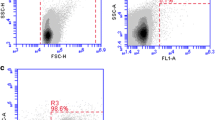Abstract
Candiduria is common in clinical practice. However, an effective and convenient assay to screen for candiduria is still needed. This study aimed to evaluate the performance of the Sysmex UF-1000i urine analyzer for yeast-like cell counting (YLCC) to screen for candiduria prior to urine culture. We retrospectively analyzed data from 5233 urine samples from 1813 patients, including 837 males and 976 females. Urine culture and urinalysis-obtained YLCC data were used to estimate the performance of YLCC in diagnosing candiduria. Different cutoff values were used to calculate sensitivity, specificity, positive predictive value (PPV), and negative predictive value (NPV). The YLCC-positive rates differed according to the Candida colony-forming units (CFU) counts in the urine samples. A sharp drop in YLCC-positive rate (from 64.3 to 22.0%) was observed between the urine groups with 104 CFUs and 103 CFUs. A cutoff value of 0 YLCs/μL results in the highest Youden index (0.71) with 77.04% sensitivity and 93.68% specificity. In a group of 34 hospitalized candiduria patients with serial urinalysis data, 25 were YLCC-positive before urine culture. In conclusion, YLCC with the Sysmax UF-1000i could serve as an auxiliary technique to exclude culture-negative specimens prior to urine culture. Positive YLCC results could imply candiduria, especially when persistent YLCC-positive results were observed.

Similar content being viewed by others
References
Fisher JF, Sobel JD, Kauffman CA, Newman CA (2011) Candida urinary tract infections--treatment. Clinical Infectious Diseases An Official Publication of the Infectious Diseases Society of America 52 Suppl 6(suppl_6):S457
Jacobs DM, Dilworth TJ, Beyda ND, Casapao AM, Bowers DR (2017) Overtreatment of asymptomatic candiduria among hospitalized patients: a multi-institutional study. Antimicrobial Agents & Chemotherapy 62 (1):AAC.01464-01417
Richards MJ, Edwards JR, Culver DH, Gaynes RP (2000) Nosocomial infections in combined medical-surgical intensive care units in the United States. Infection Control & Hospital Epidemiology 21(8):510–515
Sobel JD, Fisher JF, Kauffman CA, Newman CA (2011) Candida urinary tract infections--epidemiology. Clinical Infectious Diseases An Official Publication of the Infectious Diseases Society of America 52 Suppl 6(Supplement 6):S433
Toya SP, Schraufnagel DE, Tzelepis GE (2007) Candiduria in intensive care units: association with heavy colonization and candidaemia. J Hosp Infect 66(3):201
Karakukcu C, Kayman T, Ozturk A, Torun YA (2012) Analytic performance of bacteriuria and leukocyturia obtained by UriSed in culture positive urinary tract infections. Clin Lab 58(1–2):107
Jiménez-Guerra G, Navarro JM (2017) Comparison between urine culture profile and morphology classification using fluorescence parameters of the Sysmex UF-1000i urine flow cytometer. J Appl Microbiol 122(2) in press
Müller M, Seidenberg R, Schuh SK, Exadaktylos AK, Schechter CB, Leichtle AB, Hautz WE (2018) The development and validation of different decision-making tools to predict urine culture growth out of urine flow cytometry parameter. PLoS One 13(2):e0193255
Gutiérrez-Fernández J, Eacute RC, Sanbonmatsu S, Dios Luna J, Sorlózano A, Miranda C, Navarro JM (2014) Sysmex UF-1000i performance for screening yeasts in urine. Apmis 122(4):324–328
Le Z, Li F, Fei C, Ye A, Xie X, Zhang J (2016) Performance of the Sysmex UF-1000i urine analyser in the rapid diagnosis of urinary tract infections in hospitalized patients. J Infect Chemother 22(6):377–382
Wang J, Zhang Y, Xu D, Shao W, Lu Y (2010) Evaluation of the Sysmex UF-1000i for the diagnosis of urinary tract infection. Am J Clin Pathol 133(4):577
Aubron C, Suzuki S, Glassford NJ, Garciaalvarez M, Howden BP, Bellomo R (2015) The epidemiology of bacteriuria and candiduria in critically ill patients. Epidemiology & Infection 143(3):653–662
Toner L, Papa N, Aliyu SH, Dev H, Lawrentschuk N, Al-Hayek S (2015) Candida growth in urine cultures - a contemporary analysis of species and antifungal susceptibility profiles. Qjm Monthly Journal of the Association of Physicians 109(5)
Kauffman CA (2014) Diagnosis and management of fungal urinary tract infection. Infect Dis Clin N Am 28(1):61–74
Colodner R, Nuri Y, Chazan B, Raz R (2008) Community-acquired and hospital-acquired candiduria: comparison of prevalence and clinical characteristics. Eur J Clin Microbiol Infect Dis 27(4):301–305
Fisher JF (2011) Candida urinary tract infections--epidemiology, pathogenesis, diagnosis, and treatment: executive summary. Clinical Infectious Diseases 52 Suppl 6(suppl_6):S429–S432
Manoni F, Fornasiero L, Ercolin M, Tinello A, Ferrian M, Hoffer P, Valverde S, Gessoni G (2009) Cutoff values for bacteria and leukocytes for urine flow cytometer Sysmex UF-1000i in urinary tract infections. Diagnostic Microbiology & Infectious Disease 65(2):103–107
Rosa RD, Grosso S, Bruschetta G, Avolio M, Stano P, Modolo ML, Camporese A (2010) Evaluation of the Sysmex UF1000i flow cytometer for ruling out bacterial urinary tract infection. Clin Chim Acta 411(15–16):1137
Monsen T, Ryden P (2017) A new concept and a comprehensive evaluation of SYSMEX UF-1000i flow cytometer to identify culture-negative urine specimens in patients with UTI. Eur J Clin Microbiol Infect Dis 36(9):1–13
Funding
This work was supported by grants from the Hebei Province Medical Science Project (No. 20150371) and the Bethune International Peace Hospital of PLA Science Foundation (No. 201707).
Author information
Authors and Affiliations
Corresponding authors
Ethics declarations
Conflict of interest
The authors declare that they have no conflicts of interest.
Ethics approval and informed consent
Ethical approval was obtained from the Ethics Review Board of Bethune International Peace Hospital (2016-KY-034). The need for individual patient informed consent was waived for this retrospective study.
Additional information
Publisher’s note
Springer Nature remains neutral with regard to jurisdictional claims in published maps and institutional affiliations.
Rights and permissions
About this article
Cite this article
Zhengxin, H., Haipu, Z., Yan, C. et al. Performance of yeast-like cell counting (YLCC) using the Sysmex UF-1000i for clinical candiduria screening. Eur J Clin Microbiol Infect Dis 38, 891–894 (2019). https://doi.org/10.1007/s10096-019-03491-5
Received:
Accepted:
Published:
Issue Date:
DOI: https://doi.org/10.1007/s10096-019-03491-5




